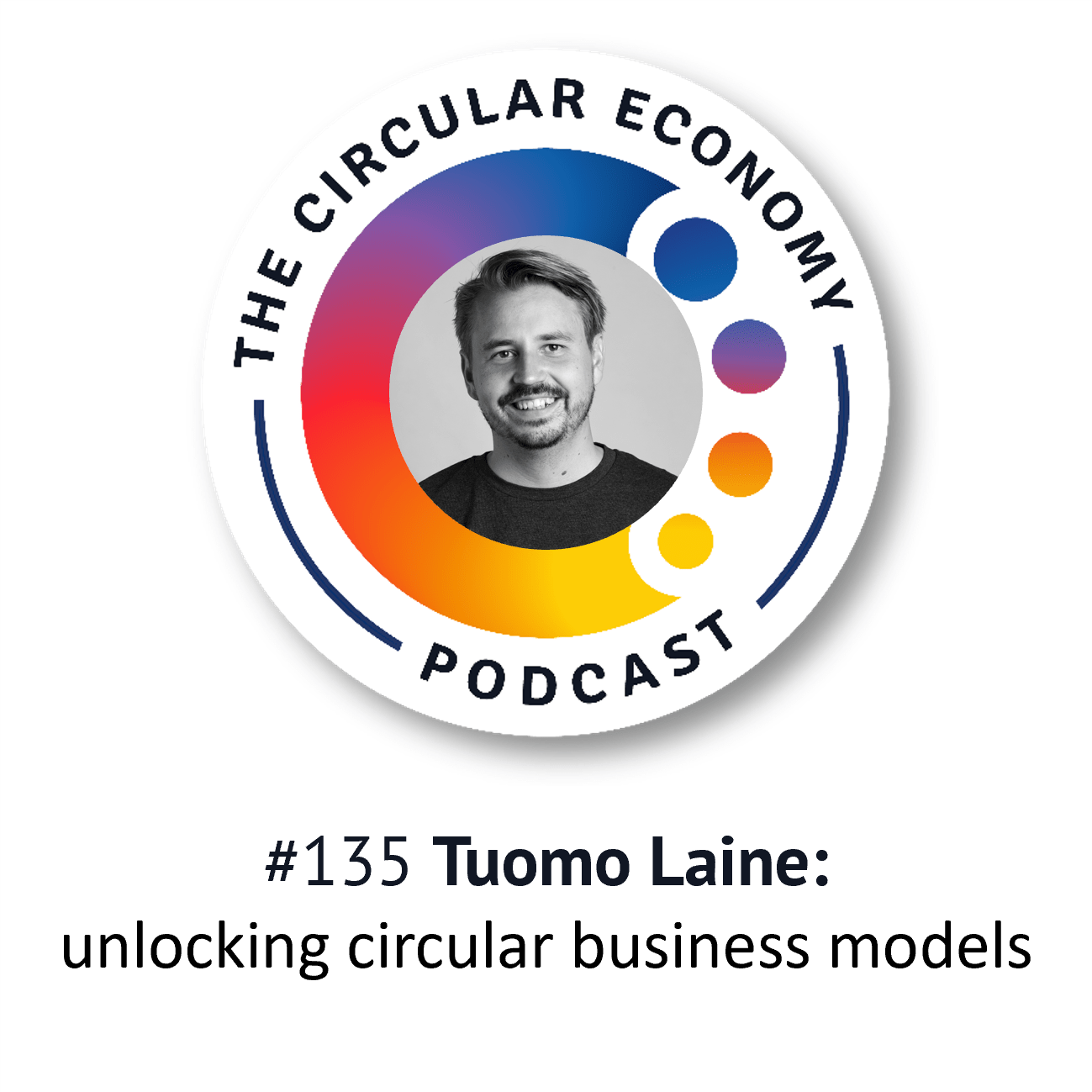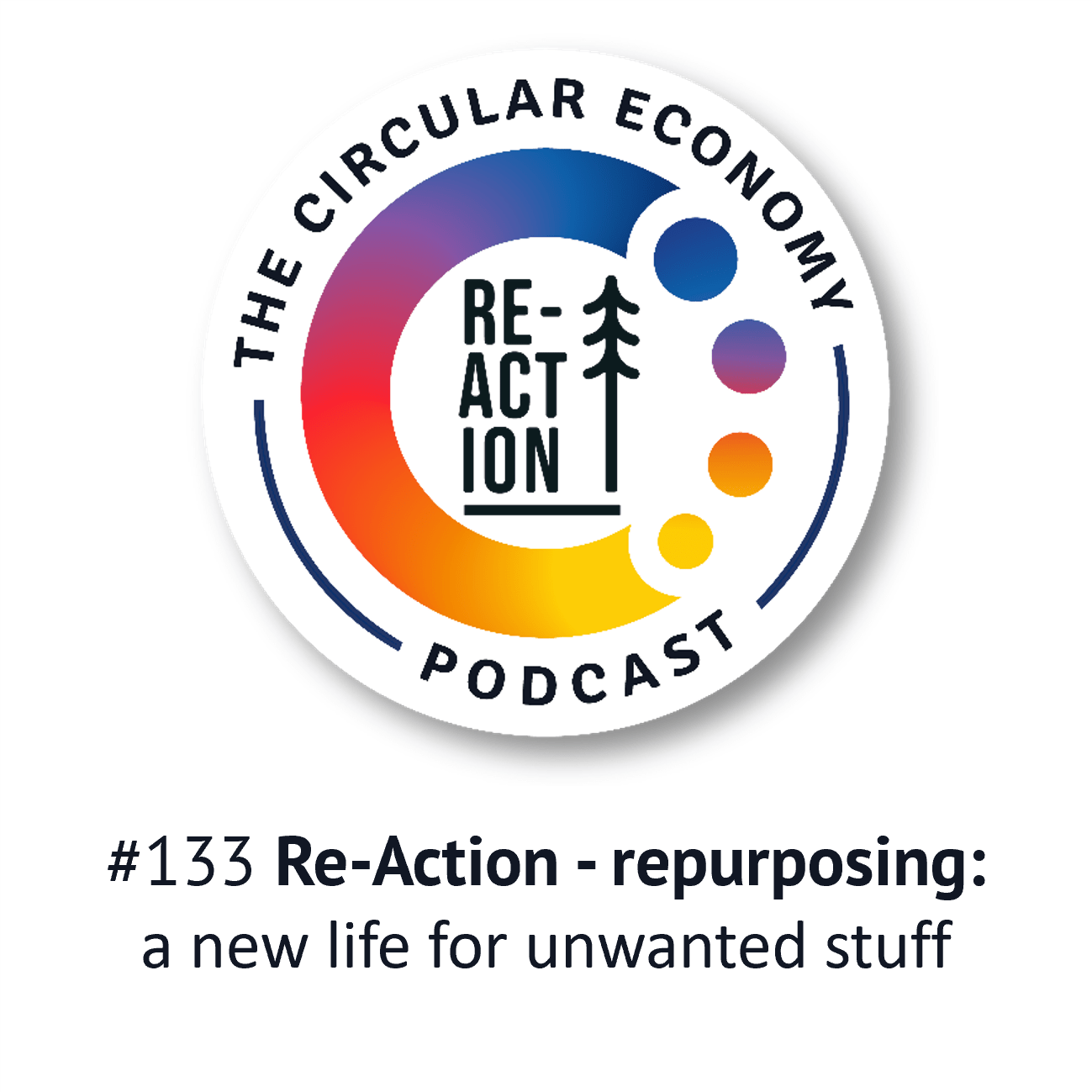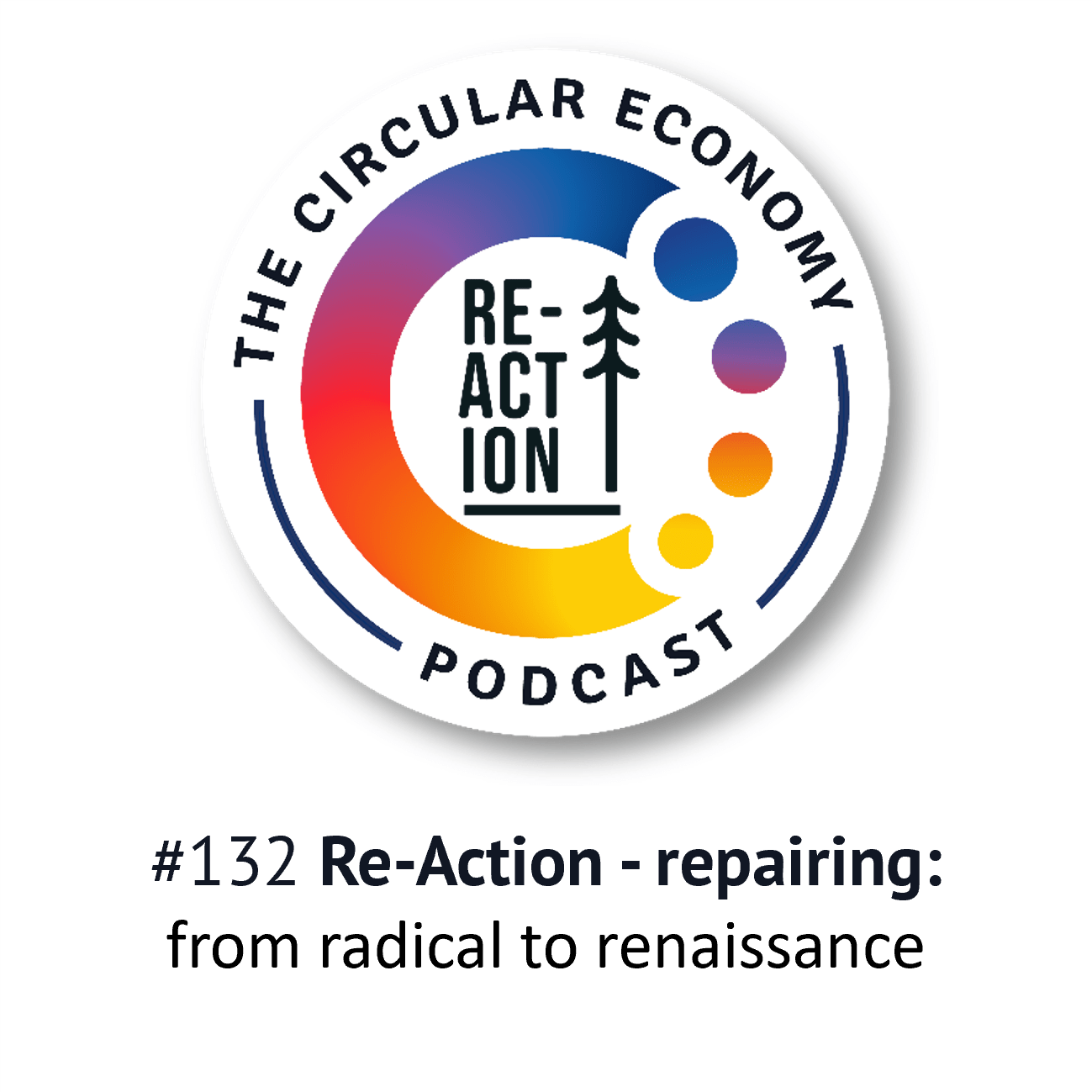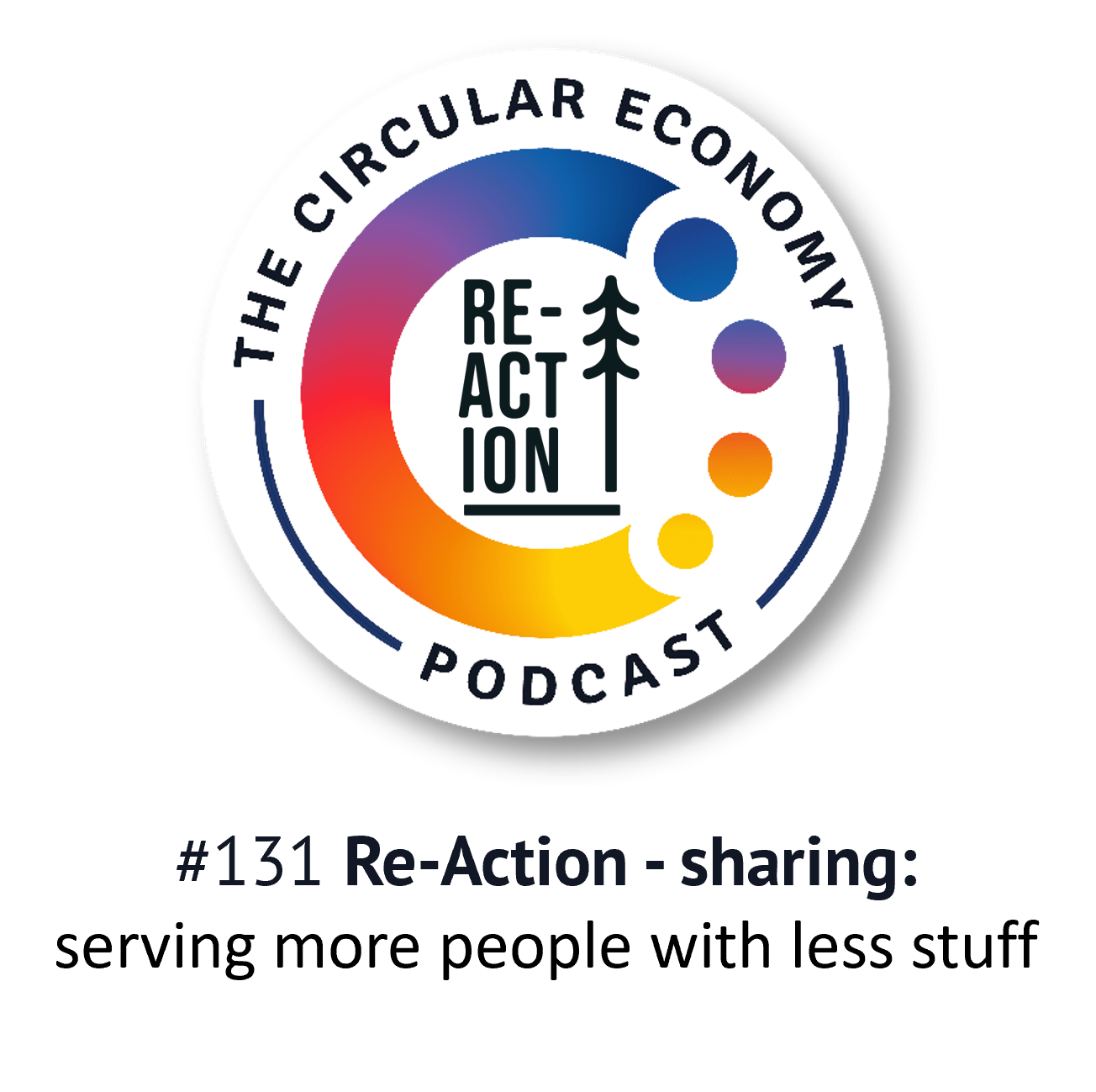Podcast: Play in new window | Download
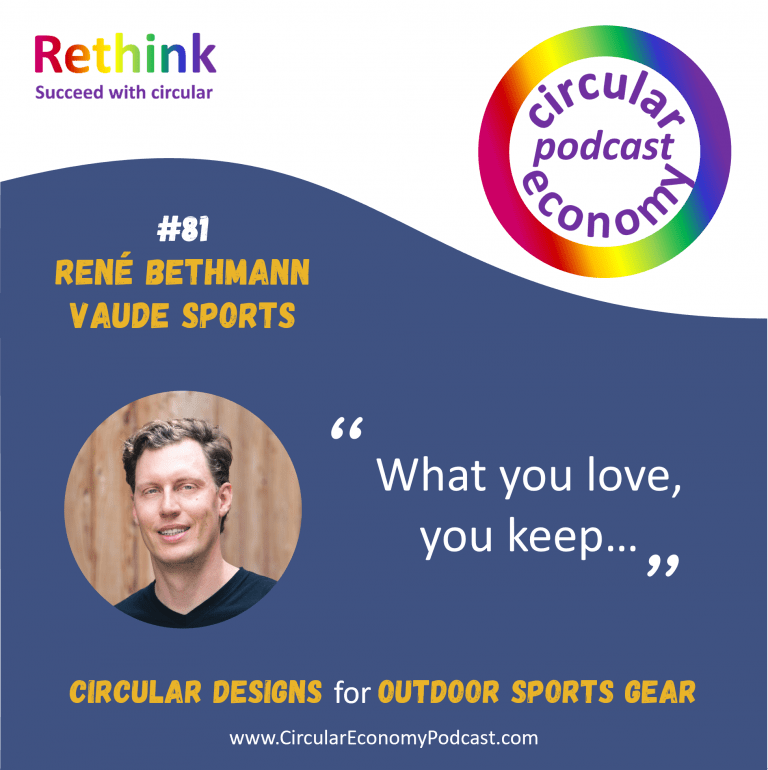
How do we navigate the tensions of having brilliant products that help us enjoy outdoor activies, yet which are difficult to repair and recycle? René Bethmann specializes in textile and apparel technology, and is leading new approaches to the design of more circular products and materials at Vaude Sports.
René focuses on emotional durability, repairability and renewable or recyclable materials. Plus, if we focus on defossilization, not decarbonization, we can unlock new ways of thinking about textiles, coatings and other materials.
Podcast host Catherine Weetman is a circular economy business advisor, workshop facilitator, speaker and writer. Her award-winning book: A Circular Economy Handbook: How to Build a More Resilient, Competitive and Sustainable Business includes lots of practical examples and tips on getting started. Catherine founded Rethink Global in 2013, to help businesses use circular, sustainable approaches to build a better business (and a better world).
Stay in touch for free insights and updates…
Read on for a summary of the podcast and links to the people, organisations and other resources we mention.
You can subscribe to the podcast series on iTunes, Google Podcasts, PlayerFM, Spotify, TuneIn, or search for “circular economy” in your favourite podcast app. Stay in touch to get free insights and updates, direct to your inbox…
Don’t forget, you can use our interactive, searchable podcast index to find episodes by sector, by region or by circular strategy. Plus, there is now a regular Circular Economy Podcast newsletter, so you get the latest episode show notes, links and transcript delivered to your inbox on Sunday morning, each fortnight. The newsletter includes a link to the episode page on our website, with an audio player. You can subscribe by clicking this link to update your preferences.
Links we mention in the episode:
- A Circular Economy Handbook: How to Build a More Resilient, Competitive and Sustainable Business – buy from any good bookseller, or direct from the publisher Kogan Page, which ships worldwide (free shipping to UK and US) and you can use discount code CIRCL20 to get 20% off. It’s available in paperback, ebook and Kindle. If you buy it from online sources, make sure you choose the new edition with an orange cover!
- Sign up to get the podcast player and shownotes for each new episode emailed to your inbox
-
Links for VAUDE
- Rene Bethmann on Linked In https://www.linkedin.com/in/renebethmann/?locale=en_US
- Rene’s talks and webinars:
-
- https://www.basf.com/global/en/who-we-are/sustainability/whats-new/sustainability-news/2021/outdoor-pants-made-of-old-tires.html
- https://vimeo.com/653685195
- https://vimeo.com/653685409
- https://bioswitch.eu/2021/01/29/successful-transition-from-fossil-to-bio-based-products-webinar/
- https://corporate.evonik.com/en/pioneers-in-green-pants-153224.html
-
- iFixit repair guides for outdoor gear and more ifixit.com
- Recommended guest: Michael Carus https://renewable-carbon.eu/news/nova-experts-introduced-michael-carus/ and read more about renewable carbon here: https://renewable-carbon.eu/
About René Bethmann
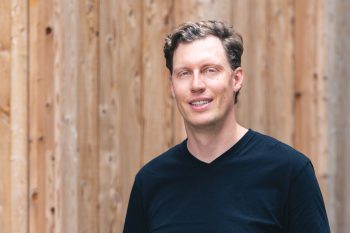 René Bethmann graduated in Textile and Apparel Technology and has worked for several leading brands across Europe in the field of product and material management (in Ticino, the Italian part of Switzerland, Norway and finally back to Germany).
René Bethmann graduated in Textile and Apparel Technology and has worked for several leading brands across Europe in the field of product and material management (in Ticino, the Italian part of Switzerland, Norway and finally back to Germany).
Currently he’s working at VAUDE as Senior Innovation Manager, managing innovation processes and related projects about material and joining technologies with strong focus on biopolymers and recycling strategies.
Furthermore, since 2020 he is a consultant of the VAUDE Academy for Sustainable Management. He is a proven global speaker in the topics of bioeconomy, circular economy, and innovative material technologies with over 15 years’ experience in the sports industry.
He lives together with his wife and 2 daughters on Lindau Island, Lake Constance.
Interview Transcript
Provided by AI
Catherine Weetman
So, Rene, for people who haven’t heard of Vaude, please, could you tell us a bit about what it does? And how it started?
Rene Bethmann
Yes, so we are an outdoor and bike sports outfitter. We are located in the area of Lake Constance that’s in the south of Germany. We were founded in 1974. And we are 100% family owned, right now with a second generation. Yeah, they’re running the company. And yeah, so as the outer sports business differs through specific purpose driven products in a natural environment compared to fashion. So, as our products protects from nature elements, we do have a responsibility to protect the nature from us, particularly. So meaning we need to look on our environmental footprint. And that’s also what is within our DNA at Vaude, that we want to give the best products out but with a lowest environmental footprint. There are also trends, but no fast trends, such as in fashion.
Catherine Weetman
Yeah, and that’s, that’s a great way to think about the clothing that we need, isn’t it, that it? It protects us from from something whether that’s shoes, you know, the simplicity of shoes, protecting us from sharp things and you know, dirty things on the floor. But often fashion creates many more needs and desires. Around that which we kind of, you know, we lose sight of the essential function of, of clothing and outdoor gear, but that I really liked the idea of thinking about how the, what we buy, in terms of outdoor gear is protecting us from nature. But there has a dual responsibility to protect nature from us in terms of, you know, what happens to it at the end of life, and so on. So, I’m keen to understand more about your design thinking approach. Maybe you could tell us a little bit about your role at rowdy at Faraday and kind of how that’s feeding into the current sustainability challenges for outdoor clothing.
Rene Bethmann
Yeah, so I’m working as a senior innovation manager at very meaning do have not like a routine worker. So I’m working with everything, which is not really available yet on the market. So in our market in our in our direct supply chains, so I’m looking for new technologies, especially new materials, and we’re where we can shift a bit away from our fossil based materials towards to the renewable and recycled materials. So because due to the fact that that we have a protective factor in our products, we rely on synthetics, so meaning on fossil based materials in our industry, long time ago, when the synthetics were not really established, that were used. So we were using wool, we were using natural materials, but when you come into the protective factor and also to the comfort factor, then synthetics are offering a much higher, I would say a much higher. Yeah, the protection in this area and also in terms of comfort. So for us, it’s important that we need to shift away from those fossil based carbon targets to renewable carbon. So when we’re looking especially on the beginning of life of our products, so at Vaude with our brand material goals, we have set ourselves a goal to make 90% of our tech starts by 2024. Out from renewable and, or recycled materials. So meaning that those tech sites will have a renewable or recycled material content of over 50%. So of course, we are aiming for 100%. But due to a viability and technical barriers, it’s often not really possible to go to 100%. Also, sometimes due to economic reasons. And yeah, and also we are aiming to extend it on our component areas, such as hard plastics, and films. So
Catherine Weetman
So that’s quite an ambitious starting point anyway, isn’t it? because 2024 isn’t far off and say 90% of the material should be renewable or recycled, but just to come back to what you said you use the term from renewable carbon sources. Could you unpack that a bit for us? Is it kind of going beyond recycled materials to something else?
Rene Bethmann
Yes, exactly. So, we knowing that a bit from the renewable energy, so when we all know that we need to shift our energy sources from the fossil based one or from the nuclear power ones towards to the renewable energy sources. So there are different possibilities, there are different pillars, I would calling them like solar power, wind power, and also hydropower and some more. And as the same concept we also need for our materials. So let us say more or less all the materials we use in our industry, they are based on carbon. So meaning we need to get away from those fossil based carbon towards to the end, renewable carbon and renewable carbon, as also for the renewable energy can come from different sources that can come from biomass.
Rene Bethmann
So bio based and also waste, so bio waste, and origins, but it can also come off from recycled sources that will be probably also in the future, some major pillar, and what is coming up. It’s also the utilisation of carbon dioxide, so that we removing carbon dioxide from the atmosphere, or also from the exhaust pipes, and converting those into chemical products. So this is just an the starting phase right now. But in the next 10-15 years, this will also gain ground. So that’s why it’s not. So that for that for like things like in the renewable energy, there’s not just one single solution. There are many more solutions as several solutions to go away from the fossil base.
Catherine Weetman
Sources. Yeah, that’s interesting. And I think I think you’re right, that we’re seeing lots of development around New Generation materials, and thinking about the carbon dioxide capture and turning that into a material that reminds me of something I included in the book a couple of years ago, Dell were capturing air pollution in India, I think it was and turning that into ink that they were using on their packaging, labels, and delivery labels. And you know, that that seemed, I guess relatively simple. From a from my point of view, I’m sure it wasn’t simple at all, in terms of the development that went into it, but it shows the potential of of, you know, turning, turning something problematic into something that that can be used to replace a fossil based carbon. So but I guess the the key thing is not so much around what the materials contain, it’s, it’s what happens to them at the end of life. And how can we make sure that these materials stay in use for much much longer? So we’re, you know, we’re not allowing the doctrine of Fast, fast fashion if you like that, you know, We only need to keep things for a relatively short time and then replace them. So how do we encourage people to keep things for longer? By making them, you know, both durable and more functional? But how do we also deal with wear and tear?
Rene Bethmann
Yeah, that’s right. And so, let us start just on the challenge we have with end of life and our industry, and so in the entire textile industry. So the big problem is that we are missing collective waste streams here. And also we missing like an infrastructure, regional infrastructure, but also global infrastructure, because we have a global supply chain. So we’re sourcing from mainly from Far East, but also from Europe, from the US from more or less all areas in the world. So and just to get things back to it. It’s also a big challenge. Plus, textile product contains a lot of different materials, but also different kinds of chemicals, different kinds of finishes. So it’s very difficult yet to sort those different components out of the products. And also a feasible business models, they are so far also not really existing, because if a feasible business model would exist for this, to do the collection and the recycling, then more companies would do that. But so far, it’s not that feasible. So in the end, it’s really important, of course, for industry to have our own close loop and not relying on waste utilisation from other industries, such as, like, recycled flakes from the bottling industry. So we have a lot of discussions here in the industry, but also working here on several working groups several initiative to make it like a comprehensive approach. And as I mentioned, how can we just avoid that our stuff is ending up in the bin, you can see and, and important, of course, is that because I text our product is a basic commodity. So it’s an object of utility. So maintaining says needed a gentle care through responsible washing, for example, is important. And you also need to know that some components like a broken zipper, or even like a hole in the textile, there are a lot of signs of wear over time, but quite a few that can be repaired. So for example, just coming back to validate here, at our own Repair Centre, we can do a lot of sales, repairs for products. And last year, so 2021, we had a repair quote of 65% of the products that came in. So we are increasing also the rate here. So the quota of the products, which can be repaired in the end is also one of our aims.
Catherine Weetman
So this is this is people send their gear back to you because it’s damaged in some way.
Rene Bethmann
Not directly to us. So as we’re not selling our products directly to the end customer, we are selling it to the dealer. So the customer need to bring the stuff then to the dealer and the dealer sending it to us, okay, then goes from the logistics, that’s user and we avoiding also in the end, like too many packages to flying around.
Catherine Weetman
Sure. So of what of what the retailers and so on are sending back to you that they think is repairable. You’re managing to repair 65% of them. And then then what happens does it go back to the consumer who’s bought it brought it into the retail centre or what happens to those repaired products?
Rene Bethmann
Yeah, so the repair products, they’re joining them back to the customer. So they’re going directly to the customer.
Catherine Weetman
And did I read something about Vaude helping people do their own repairs through Ifixit?
Rene Bethmann
Yeah, that’s right. So a few years ago, we started a cooperation with IFixIt. It was known for doing repair guides and spare parts for for doing mobile phone repairs. So and we are providing year the user with repair manuals and also with spare parts, supplies so that the customer can do the repairs also by themselves. If something is broken for example, because This can happen. It’s a product, which is meant to be used in the end. And of course, it will not last forever. But you can prolong the use phase. And that’s one of the most important thing when it comes to you also to sustainability, that the products are durable. And one thing I also would like to add here is, we also developed our own repairability index, which allows us to rate the repairability of our products. And then we can also see where actually our sticking points where can we improve also, where we maybe need to design the zipper in a different way on a jacket, that it’s easier to been replaced?
Catherine Weetman
Yeah, that’s a great point. And, and I’m sure there are lots of simple things that you can do at the design stage to really help things be more repairable. And just just to come back on the I fix it, resources, because the scope of the products that the Ifixit community covers now is is growing and growing. And I found the Ifixit sort of outdoor gear section really helpful is it had a very good diagnostic to help you even decide which kind of zip you’d got. Because that that isn’t as obvious as you’d think. And, you know, I was amazed how many different types of zips that there were and, and why some of the zip replacement zip fasteners that I bought that fitted, okay, then then decided that, you know, they just wouldn’t go up and down the zip. And you know that they looked visually exactly the same, they were the right size and everything, but it turned out to not quite be the same type of zip. So that’s a great place to start before you before you embark on any repairs would be would be my advice. So, Renee, how are you How’s vow to helping people understand what’s happening behind the scenes with all your design work and the other sustainability and circular features of the products and processes?
Rene Bethmann
Yeah, so we are trying to be as as transparent as possible. We’re also setting the benchmark in the integration of different standards combined in our own equal design tool, equal design labour, we call it green shape. And yeah, our sustainability report, for example, is not just a PDF, document, what you can download, and then you can read through 100 pages. So it’s, it’s a, it’s an interactive website, where people can click through more or less all topics, which are related in terms of sustainability in our company, and also topics which are driving the industry. So, and once we are making our statements public, yes, to more or less every challenge we are facing, we are also having and the statement we also mentioning where we are working on and how we want to improve it. Of course it goes not everything at the same time. But over time, we are making yet improvements. And in addition, we also providing insights on congresses and speeches and giving holistic and specific consultation to other institutions and companies with our Vaude Academy for Sustainable Business. So and here consulting. So that’s like a consulting service we offering from the people who are literally working on the transformation and the daily business. So it’s not that we have in at only consultants here, who are just doing consulting and nothing else. So the people also having like a normal daily job, actually, and this is also coming directly from the practical work into them as a consultant work.
Catherine Weetman
So they’re, they’re offering their skills outside Vaude. Okay, that’s really interesting. And to to local businesses or to other companies in the outdoor gear space. I wasn’t quite clear on on that.
Rene Bethmann
That’s yeah, that’s quite interesting. So it’s not really that much for so coming up. So So, so far, not that many requests coming from the sports industry, but from complete other industries, like even automotive industry, or furniture industry and coming request ins, and that’s really interesting. So I complete different industries, but they’re also having the challenge Just on how to tackle the topic sustainability and where they can actually make it a bit better inside the company in from the management level from the organisation, but also more specific on how to look on different materials. What about bio polymers out to evaluate those? Yeah. So we have a quite broad feel to what we can offer.
Catherine Weetman
Yeah. And that’s the first time I’ve come across that kind of model. It sounds really interesting. And I’m sure employees benefit, as well by, you know, seeing how other companies are approaching things, and maybe getting better at finding ways to explain things because, you know, when you spent a long time in one company, everybody talks a similar language, don’t they? And everybody knows what, what’s, what’s gone before and the context of where you’re starting from now. Whereas, when you’re talking to a completely different industry, you know, what, what they’re used to, and what they know and don’t know, is is a completely different picture. Yeah, so that yeah, that’s, that sounds like a really interesting challenge for employees and value adding for, for value as well. And one of the things that I’m kind of looking at now is, is the trend towards onshoring, and reshoring. The just seem to have been so many supply chain challenges across all sorts of industries over the last few years, you know, some obviously caused by COVID, and the lock downs. And then other weather related issues, or the Panama, the Suez Canal issue. So all sorts of things are happening. And I’m starting to see more in the financial press, particularly about the benefits of insuring and reshoring. How, you know, How involved are you in that? Is that something that you’re looking at? We talked about your, you know, international supply chains earlier? What’s the thinking going forward?
Rene Bethmann
Yeah, of course, we always looking to have a bit more near to where we also selling our products. So well, that’s our supply chain is also close to our selling points. And we are selling mostly within Europe. And the big problem is here. And that’s not only for us, it validates like for the general outdoor sports industry. It’s about the knowledge. So we started a long time ago to shift everything to forest and forest there to tap like knowledge, like the expertise and also the craftsmanship of manufacturing. Those products, because they are complicated products is not just like an t shirt. That’s an easy product, but a waterproof breathable jacket. It’s a very complex product. So you need a lot of craftsmanship here. So an asset from the textiles, it is almost impossible to find the same fabrics, what we’re getting in forest, here in into Europe, for example. Of course, there are also some specific fabrics, you just can find here are the best quality you can find here. But we just simply do not have the that infrastructure here anymore. So and that’s the big problem of bringing it back. And also challenge when we’re looking on the production of our products. So meaning, like in the garment manufacturing, that’s also a big challenge, because it’s difficult also to find people first want to work in this industry wants to do that job, and also who gets the skills to get the skills and the craftsmanship, to do the job. And that’s a big problem what we have in years. So of course, we need hearing more automatization but it’s much more complex. With our material we haven’t because the textile is a flexible material. It’s very, very difficult to make in here big steps in the automatization. So but we also need to look what can we do here. And the interesting point is that when you really looking on the very beginning of life, you see that a lot of sustainable technologies. They are established in Europe.
Rene Bethmann
So we have here in Europe, we have a lot of knowledge about recycling technologies, also, for example, carbon capture technologies and even from use biomass, that organisation, we also have a lot of technologies here. And we also have a lot of chemical industry also still here in Europe. So one step or one possibility would be you said we going more upstream in our supply chain. And looking okay, can we also buy those chips, for example, those chemicals from Europe, and then they can go overseas. Because we also know that the transport itself, it has not that big impact. And then furthermore, if we also want to aim or the want to go more in the direction of reducing our environmental impact. So speaking about climate, climate neutrality, we have more options here in terms of renewable energies than anywhere else. So that’s also a big plus point. And when we’re looking at the same time, at the end of life of our products, which are basically mainly ending up here, in Europe, we have more possibilities and future also, to do the valorization. Regional, and not sending them our waste material through forest and they doing the valorization. We can do the valorization here in Europe. And that’s like an interesting perspective, I would say, well, it’s the first step you can do. And then over time, we need to see how it will end up with a textile manufacturing. If it’s Is there any possibility to do like a near or onshoring? But so far? It’s kind of tricky, I would say. And furthermore, we have, for example, in that Taiwan, where we sourcing most of our fabrics, we just simply finding the best fabrics, and the best quality you can get on certain textiles and materials.
Catherine Weetman
Yeah, it sounds sounds, you know, much, even though I’ve worked in supply chain in the past, there are just so many different aspects to think of, you know, as well as the capabilities of each of your suppliers and the availability of you know, the the next stage of the supply chain, the next bit of upstream for them, have they got access to the kind of materials that you need, and upstream of the materials. What about the chemicals for the for the coating and, and performance enhancement of those technical products? But things like the, you know, what, what’s their local energy source? If they’re powered by coal, and you really want to reduce your company’s carbon footprint, then there could be a benefit in spending more on the manufacturing part of it in order to tap into local renewable energy sources. So yeah, it sounds as if it’s, there were just so many different elements to consider with each of the decisions. So yeah, I can imagine that’s a big discussion topic. And thinking about the knowledge that you’d pass on to another business that wanted to go circular. And particularly with the kind of conversations that your employees who are who are offering consulting, the kind of conversations that they’re having, what would be your number one lesson learned to share with another business wanting to go circular?
Rene Bethmann
It’s about transparency. And also knowing your supply chain, knowing your supply chain, meaning not only knowing your direct supplier, so like your tier one or tier two supplier, you need to go upstream, you need to understand who is involved, and where is the stuff coming from. Because if you don’t have this transparency in the end, in your supply chain, it’s very difficult to make long term changes, and also reducing your emissions in the end. So that’s a really important point when it comes about consulting and also about Yes, a sustainability in general, because there are a lot of like a lot of brands and also a lot of other companies industries, who are doing really good products in the end, but often they don’t know their detailed upstream supply chain, and it’s one to reduce your impact. It’s for them kind of, yeah, that’s for them kind of a bottleneck because they don’t have except many options was a direct suppliers. But when was it going more upstream? They probably having more options in them. And also they can find more sustainable materials, they can offer them to zero suppliers.
Catherine Weetman
Yeah. And you can just have much, much more fulfilling and and kind of explorative conversations with the suppliers. Can’t you remember from my industrial engineering days that, you know, the best bit of advice in terms of how to improve the effectiveness of a particular process was to ask the person doing the job themselves, because they were the ones who were closest to, you know, the frustrations of how something had been designed, or the frustrations of the tools we were giving them to work with and so on. So yeah, I think knowing knowing your entire supply chain is is a great tip, and thinking about values Rene, whether those are your personal values, or the the values and the purpose of Vaude. Which one would you share with our audience in terms of helping to move us towards a better world, one that’s more sustainable and fairer?
Rene Bethmann
Coming first, our products here, this directly is about emotional durability. So I think that is a really important password, the emotional durability of products because of what you love, you keep. And you need to create an emotional connection to your products, because it should display how much work is integrated in a textile product. Because in the end, it’s the this and the craftsmanship. So there are people behind every product. And your outer products is an archive of your adventures. So every scratch tells a story, like scars of the human skin, cell and personal, I would say you should not only question what others should do instead, just start with yourself. Every single person can make a change in private. So in business, so and then convincing others eat smart, of course. And also question yourself, do you really need a car? So is it really important or as other options are in the end? Can you save a lot of money if you’re not owning a car, if you’re just renting a car in cash sharing, using other transport systems? And also you don’t need to travel to far-distant places? Because in the end, you will find on the most remote location, just another German!
Catherine Weetman
Yeah, that’s really funny. But yeah, I think over the lockdown when people couldn’t travel, lots of people have realised that they can have different kinds of adventures or micro, you know, lots more micro adventures if you’re not having to shedule in long distance travel and so on and finding different ways to connect with nature. And, you know, if I don’t need to commute every day, maybe I don’t need a car. So that’s opened up all sorts of possibilities hasn’t it felt for living differently? And a friend a thinking about who you know, that’s that’s doing circular economy and sustainable stuff? Who would you recommend as a future guest for the podcast?
Rene Bethmann
Yeah, so as a future guests, I would really recommend Mr. Michael Carus. He is the founder of the Nova Institute, and the initiator of the renewable carbon initiative. So he has a long history, in the field of materials and also in the field of shifting away from the fossil economy, or what’s the renewable, renewable carbon industry. And he is doing a lot of publications with Nova Institute. And it’s for me also often like the benchmark, you can get cast it’s, it’s always scientifically based but not just only scientific based, because it’s also coming on to the practical since then, and that’s a lot of statistics. They also especially when it comes to renewable carbon and why we need to have this one as the best word and also why we should not talk in our industry about decarbonisation. We should rather talk about the de-fossilisation because as I mentioned before, more or less all the materials we are using, they are based on carbon, and even like the human body is based on carbon. So, going forward decarbonisation so far should be taught and in the end, so we need to go to the renewable carbon and also keeping the carbon in a loop and not emitting more carbon to the atmosphere. I assets important thing and Mr. Michael Carus, he actually can talk a lot about both things, and the concept behind.
Catherine Weetman
That sounds fascinating. And yeah, I just made a note of that, that the importance of de- fossilisation, not decarbonisation and, yeah, we mentioned the Dell example earlier. And when you, you know, coming up coming up with that phrase just made me think about another story I’d read a few years ago about using trees to I think it was to make carbon fibre, so kind of missing out the need for the fossilisation aspect. And going straight from the tree, you know, a renewable, much more renewable source. So that’s sounds fascinating. And I’ll follow up to get the spelling of his name right, And details later. So brilliant. So Rene, how can people find out more about you and Vaude, and get in touch?
Rene Bethmann
Yeah, about myself, of course, I have my LinkedIn profile. The other social media channels, I’m not using that much. And otherwise, on the Vaude website, you can find a lot of our products. And if you want to go in our environmental section, or on our sustainability report, as I mentioned, it’s a website. You also can go directly here, if you’re putting in sustainability report, Vaude,, then you can get to this to the website, and where you can click through it. We have it in German, and we have it in the English language. So yeah,
Catherine Weetman
great. Well, I’ll, I’ll put those links in the show notes as well so that people can go straight to the sustainability report, which sounds as if it’s industry leading in terms of format, and transparency, and so on. So I’m sure that will give people lots of good insights into how they can take their own businesses more sustainable, whether it’s in a completely different industry or something similar. So Thanks, Rene, for sharing those insights on how Vaude Sports is helping slow the flow on outdoor gear and build in much more emotional durability. And I look forward to what’s coming next, particularly around the fossilisation and not decarbonisation, and that concept of renewable carbon that sounds fascinating, and in the meantime, keep being part of the solution.
Rene Bethmann
Yes, thank you very much.
Want to find out more about the circular economy?
If you’d like to learn more about the circular economy and how it could help your business, why not listen to Episode 1, or read our guide: What is the Circular Economy?
To go deeper, you could buy Catherine’s book, A Circular Economy Handbook: How to Build a More Resilient, Competitive and Sustainable Business. This comprehensive guide uses a bottom-up, practical approach, and includes hundreds of real examples from around the world, to help you really ‘get’ the circular economy. Even better, you’ll be inspired with ideas to make your own business more competitive, resilient and sustainable.
Please let us know what you think of the podcast – and we’d love it if you could leave us a review on iTunes, or wherever you find your podcasts. Or send us an email…
Podcast music
Thanks to Belinda O’Hooley and Heidi Tidow, otherwise known as the brilliant, inventive and generous folk duo, O’Hooley & Tidow for allowing me to use the instrumentals from the live version of Summat’s Brewin’ as music for the podcast. You can find the whole track (inspired by the Copper Family song “Oh Good Ale”) on their album, also called Summat’s Brewin’. Or, follow them on Twitter.
